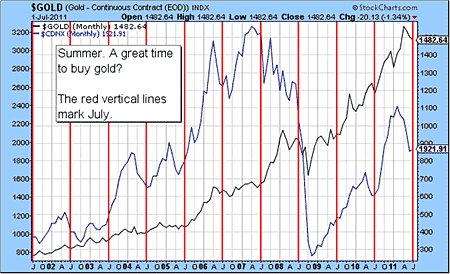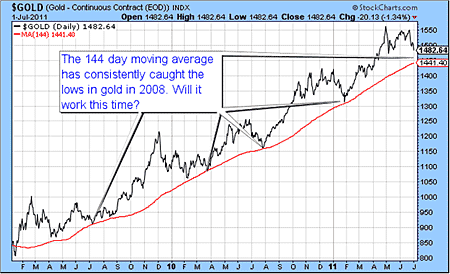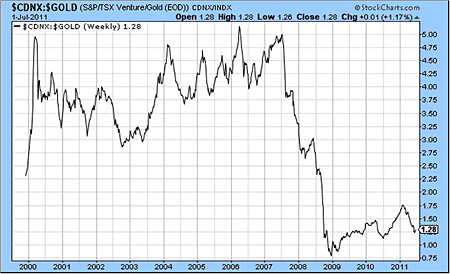Five reasons to buy gold and silver stocks now
Silver, and to a lesser extent gold, have had a wobbly couple of months. Precious metals miners have rarely looked cheaper compared to the metals themselves. That’s just one reason why now is the perfect time to buy back in to the sector, says Dominic Frisby.
We're back in the buy zone, folks, for gold, silver and the mining stocks. It might be another week or three before we hit rock bottom. Then again we might already have seen it. But I'm confident we're in the zone.
A number of boxes on my check-list have been ticked.
For those that like a flutter, it's dipping your toe in' time.
MoneyWeek
Subscribe to MoneyWeek today and get your first six magazine issues absolutely FREE

Sign up to Money Morning
Don't miss the latest investment and personal finances news, market analysis, plus money-saving tips with our free twice-daily newsletter
Don't miss the latest investment and personal finances news, market analysis, plus money-saving tips with our free twice-daily newsletter
Here are five reasons you should be buying in now:
1. It's early July
I don't know why it happens I can offer suggestions but I don't really know why it is that July and August repeatedly prove to be the best time of year to buy precious metals and precious metals stocks.
The simple strategy of accumulating over the summer and off-loading early the following year keeps on working.
This first chart shows gold (black line) and the CDNX (the composite of the Toronto and Toronto Venture Stock Exchanges blue line), which I use a proxy for junior miners. The vertical red lines mark the month of July.

As you can see, with gold (the black line) a low for the year repeatedly comes in the July-August time frame. The strategy of buying gold in the summer and off-loading early the following year has worked every year since 2001, with the exception of 2007-08.
Our juniors proxy, the CDNX (the blue line), is not as consistent as gold. But if the low doesn't come in the July-August time frame, it comes the following October. If not one, then the other. It's remarkably consistent in that regard. Again the year that broke the rules was 2008.
2. The COT report looks bullish for silver
The COT report shows the commitments of the futures traders on the Chicago futures exchanges. Broadly speaking, the fewer open positions (open interest), the more bullish the set-up, because the more potential buyers there are still to come into the market.
In a strong uptrend the open interest will expand the new buyers are stronger than new sellers. A rising trend with declining open interest suggests that the market is being pushed higher more because short sellers are exiting positions than because new buyers are establishing positions. That's a sign that a move is tiring.
In general, I have found the COT report to be a better identifier of lows than of tops. And the open interest in silver hasn't been this low since late 2008, when silver was trading below $10. In other words, to me it looks as though buyer demand for silver can only go up.
Back in the spring, when silver had its mega correction, I said the most bullish setup would be for $33 to hold. It has held. It's been repeatedly re-tested and it has held. Not only has it held, but the weak hands have now been flushed out, as evidenced by the COT open interest. So there is a lot of room for new buyers to come into the market.
A lot of people sold silver at $50. But were they clever enough to buy back in at $33? If not, there could be a scramble.
I am also extremely impressed by the way the gold-silver ratio has stayed below the key 45 level. Silver has stayed strong relative to gold.
We have had a run over the last two days, so some caution is recommended. But I am feeling very bullish about silver in the intermediate term. I expect a retest of $50 before year-end or perhaps even sooner than that.
3. We've almost reached the 144-day moving average again
Since the bust of 2008, the 144-day moving average which shows the average price over the previous 144 days has been the best gold indicator I have found. (Hats off to the trader Michael Hampton who first alerted me to it).

Gold repeatedly pulls back to it during sell-offs, and it has marked an optimum entry point. The average currently sits at $1,441 and rising. Gold began the week close to it at $1,480. I daresay the twain shall meet somewhere in between at some stage over the next month. Then again, $1,480 held after the spring sell-off. It held during the weakness of the past ten days. That may be the low.
4. Gold stocks are cheap
Gold stocks remain cheap compared to gold. Of course, there are all sorts of reasons for gold stocks under-performing. Rising mining costs, foreign exchange fluctuations squeezing profits, and general poor sentiment towards equities are just a few. And just because they're cheap doesn't mean they can't get cheaper.
But valuations are starting to look compelling even to a cynic like me. With the horrible exception of 2008, gold stocks are as cheap relative to gold as they've been in eight years.
And if you look at the ratio between gold and the junior mining stocks, with the CDNX as proxy (see below), junior gold stocks are as cheap as they've ever been, bar a few months in 2008.

5. I can't find a bull out there
There are the permabulls. But that's it.
I don't use a technical measure of investor sentiment, as some do. I follow investor chat boards. I listen to interviews. I read a lot. I go to presentations. I talk to people. My reading of investor sentiment is nothing scientific, just a judgement based on what I'm seeing and hearing.
There is no elation out there. There was last autumn, but not now. There is a feeling of fatigue, wariness and cynicism. There is also a feeling that 2008 is coming again. Maybe it is. In which case, all bets are off.
But what if it isn't? In general an atmosphere of fear and loathing is a better atmosphere to buy into than one of celebration.
All in all, I think there is a strong case to be buying into precious metals and precious metals stocks for an intermediate-term trade into early next year or for longer if that's your style.
It looks to me like we are entering the second phase of the financial crisis. When the banks were bailed out in 2008, we noted that all that was happening was that debt had been moved from the balance sheets of private corporations to those of governments. The next phase would be marked by sovereign debt default.
We are there now, whether it's southern Europe, or the US's issues with its debt ceiling. They might be able to put it off for a few more months, but it is coming. It is all incredibly bullish for gold. Sooner or later gold will pull its related stocks up, like a fierce mother with an errant child.
I have published a new Gold Report, which comes out today. I've deliberately tried to time the release to catch a summer low, so that investors have plenty of time to position themselves ahead of the normally sleepy summer months for an autumn run. We'll see if that works.
Our recommended article for today
Is this the start of the next of the next bear market?
Are we looking at the start of the next great bear market in equities? Simon Caufield investigates, and looks at where three of the best bear market signals are pointing right now.
This article is taken from the free investment email Money Morning. Sign up to Money Morning here .
The Gold Profit Plan is a regulated product issued by MoneyWeek Ltd. The FSA does not regulate certain activities, this includes the buying and selling of some commodities such as gold. Advice relating to investing in gold related shares or products is regulated by the FSA.
Get the latest financial news, insights and expert analysis from our award-winning MoneyWeek team, to help you understand what really matters when it comes to your finances.
MoneyWeek is written by a team of experienced and award-winning journalists, plus expert columnists. As well as daily digital news and features, MoneyWeek also publishes a weekly magazine, covering investing and personal finance. From share tips, pensions, gold to practical investment tips - we provide a round-up to help you make money and keep it.
-
 ‘Why I have ditched my Help to Buy ISA for cash savings and the stock market’
‘Why I have ditched my Help to Buy ISA for cash savings and the stock market’Without the 25% bonus, my Help to Buy ISA is effectively redundant, says MoneyWeek writer Sam Walker.
-
 Is your inheritance tax allowance cut if you sell to downsize or sell your home to pay for care?
Is your inheritance tax allowance cut if you sell to downsize or sell your home to pay for care?Downsizing relief is a little-known benefit that could save your loved ones tens of thousands of pounds in inheritance tax after you’ve died.

